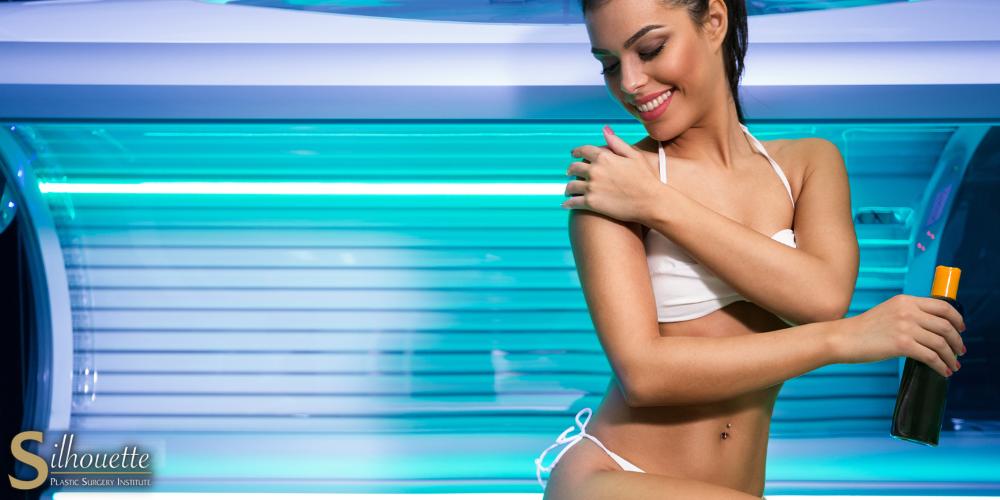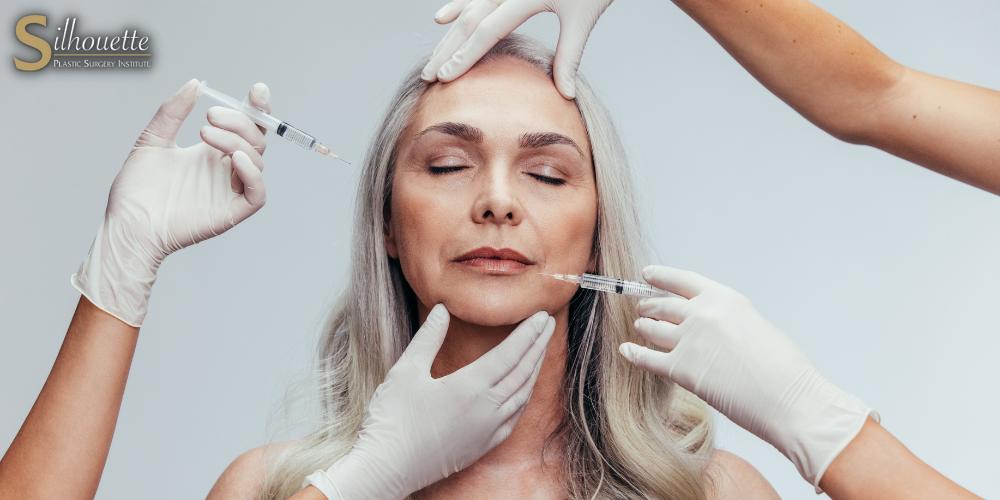Did you know: there is no such thing as a safe tan according to Dermatologist Jennifer Lucas, MD. Even still, tanned skin is considered one of many beauty standards that many of us feel that we must meet. So much so that the American Academy of Dermatology states that 63% of teenagers that they surveyed believe they look better with a tan. The most common method of staying tanned year-round is through indoor tanning beds. Over the last couple decades, though, medical professionals have determined that UV exposure from tanning beds significantly raises a person’s risk of skin cancer, even more so than outdoor tanning. This also begs the question: do tanning beds cause wrinkles? The short answer is yes. Below, we discuss the dangers of tanning beds for not only your overall health, but for your youth too. We also break down some of the best medical spa procedures that can turn back the clock on aging if you’ve spent many years soaking up UV rays in tanning beds.
If you’re looking to get your youthful glow back, look no further. Our Bakersfield Medical Spa offers countless non-invasive procedures that can make you look and feel young again. Call 949-359-8397 to schedule an appointment at Silhouette Plastic Surgery Institute today.
Are Tanning Beds Bad for Your Skin?
Yes, indoor tanning beds are extremely harmful to the skin, even more so than outdoor tanning in natural sunlight. Both indoor and outdoor tanning can lead to significant skin damage, but medical professionals claim that the average tanning bed emits 3 times to 12 times more UVA light compared to natural sunlight.
UVA Rays vs. UVB Rays
In order to fully understand why indoor tanning is so dangerous for our skin and overall health, it’s important to understand the difference between UVA and UVB rays.
According to the Skin Cancer Foundation, ultraviolet A (UVA) light has longer wavelengths that cause skin aging and tanning. Meanwhile, ultraviolet B (UVB) light has shorter wavelengths that cause sunburns and blistering. Both types of UV radiation are associated with an increased risk of developing melanoma and non melanoma skin cancer.
Tanning beds emit mostly UVA rays. Additionally, up to 95% of the UV rays that reach the Earth are UVA.
UV Exposure and Vitamin D
We all know that vitamin D is a crucial component of good health, and that sun exposure is a natural source of vitamin D. Natural sunlight creates vitamin D in the body though cholesterol in the skin cells. This leads to a long, complicated vitamin D synthesis process in the body.
Because it would take so much sun exposure to meet the recommended daily vitamin D intake, the immense skin damage would definitely outweigh the health benefits. That’s why people believed for many years that not only were indoor tanning beds safer, but they would provide adequate vitamin D as well.
Both of these beliefs are incorrect. Indoor tanning equipment is incredibly dangerous to the skin and overall health (other health detriments include immune system suppression and eye damage). Not only that, but the harmful UV rays from indoor tanning produce little to no vitamin D in the body. Why? Because UVB rays are responsible for vitamin D production, not UVA rays. Remember – indoor tanning beds emit mostly UVA rays.
That’s why all medical professionals recommend people to just skip the sun damage from both indoor and outdoor tanning and get enough vitamin D through dietary supplements and fortified foods.
Tanning Beds and Skin Cancer
Skin cancer is the biggest health risk from prolonged UV radiation. In fact, major health organizations such as the American Academy of Dermatology and the American Cancer Society state that tanning bed use significantly raises the risk of developing skin cancer. Additionally, the International Agency for Research on Cancer (IARC) claims that tanning beds are definitely carcinogenic to humans, rather than probably carcinogenic.
But how does ultraviolet radiation actually cause skin cancer? It happens through cumulative DNA damage within the skin cells. The most common types of skin cancers that you can develop from UV light exposure are basal cell carcinoma, squamous cell carcinoma, and melanoma – the deadliest form of skin cancer.

Do Tanning Beds Cause Wrinkles?
Yes, tanning beds do significantly speed up the aging process, leading to premature wrinkling of the skin. Long-term exposure to natural sunlight does the same thing, especially without frequent sunscreen use. However, as previously explained, tanning salons are much worse in the realm of premature aging because they emit mostly UVA rays. UVA rays are most associated with skin aging.
Not only do UV rays cause early aging and wrinkling, but they also cause dark spots, sagging, moles, changes in skin texture, and so much more. How? UV rays damage the elastin and collagen fibers in the skin, both of which are necessary to maintain that youthful appearance that everyone wants.
Med Spa Procedures That Can Get Rid of Wrinkles
Skin wrinkling and sagging is a natural part of life, especially as we get older. However, if you’ve spent a lot of time under the sun or in a tanning salon, you may be noticing yourself aging way faster than you’d like. Luckily, there are lifestyle changes and medical spa procedures that can potentially slow down (or reverse) the aging process.
Below, we break down all the anti-aging procedures that we offer at our Bakersfield Med Spa.
Laser Treatments
Although it sounds counterproductive, intense light energy from laser treatments are incredibly effective at removing lines, wrinkles, sun spots, acne scars, and so much more from the skin. Laser treatments work by damaging the outer layer of skin (the epidermis), which then triggers collagen production. As we explained earlier, collagen is a crucial component of young and healthy skin.
The Med Spa at Silhouette Plastic Surgery Institute offers many types of laser treatments, including CO2 laser skin resurfacing and pico laser treatment, both of which can address multiple types of skin concerns.
Plasma Fibroblast Therapy
Plasma fibroblast therapy uses intense heat energy to create tiny skin wounds (AKA: micro injuries) which then trigger collagen production. While this type of skin treatment can definitely improve the appearance of wrinkles and sun spots, it’s mostly known as a “skin-tightening” procedure. So if your main concern is skin sagging from sun exposure, plasma fibroblast therapy can help.
RF Microneedling
Radiofrequency microneedling is another procedure that works by creating micro injuries in the skin with tiny needles, therefore triggering collagen production. Collagen is the secret to anti-aging, meaning fewer wrinkles, less sagging, less dark spots, etc.

Botox and Dermal Fillers
Botox and dermal fillers may be able to slow down the aging process as well. Botox doesn’t get rid of wrinkles, but it can definitely smooth them out and make them less noticeable by relaxing the underlying facial muscles.
Meanwhile, dermal fillers may be able to address facial sagging and “hollowness” caused by aging and excessive sun exposure. One type of dermal filler, called Sculptra, even triggers collagen production in the skin. So not only can it address hollowness and sagging, but it can reduce the appearance of wrinkles as well.
Ultherapy
Lastly, our Bakersfield Med Spa offers Ultherapy which can also turn back the clock on aging. The ultrasound energy treatment is often referred to as a “non surgical facelift,” and is FDA approved to reduce wrinkles and tighten skin in the following areas:
- Forehead and brow area
- Lower face and neck
- Jawline and chin
- Lower neckline and upper chest area
Similarly to our other skin treatments, Ultherapy works by heating up the skin which then triggers collagen production. The result is a smoother, tighter, more youthful face.
How to Prevent Premature Aging From UV Radiation
Most of the time, the best anti-aging treatment is daily prevention. If you want to protect your skin, preserve your youth, and avoid expensive skin procedures, this is what you should do:
- Avoid Tanning Beds: Indoor tanning beds provide absolutely zero health benefits. In fact, they are incredibly damaging and drastically increase the risk of skin cancer, even if you use them just once in your life. If you enjoy looking sunkissed year-round, it’s better to just use self-tanning creams and lotions.
- Wear Protective Clothing While Outside: This includes wide brim hats, pants, and long sleeve shirts. Clothing is often a better skin protection option than sunscreen.
- Wear Sunscreen to prevent sunburn, aging, and skin cancer. No one wants to be fully clothed at the beach, so sunscreen is a must. Even if you’re not planning on spending time outside, you should wear facial sunscreen of at least SPF 30 every day. Most people think that they don’t need sunscreen if they’re going to be sitting inside all day, but what they fail to understand is that UV light can go through glass, such as car, home, and office windows.
- Sit in the Shade: There’s no denying that going outside and enjoying sunlight is crucial for both mental and physical wellbeing. Our circadian rhythm is partially influenced by sunlight, telling us when to stay awake and when to go to sleep. Additionally, sitting outside on a nice day and breathing in the fresh air is important for lowering stress levels, which supports all bodily systems. With all that being said – you can enjoy a beautiful sunny day in the shade. You should especially sit in the shade between the hours of 10am to 4pm, which is when the sunlight is the most intense.

Call the Med Spa at Silhouette Plastic Surgery Institute Today
If you’re noticing premature aging from your days of soaking up the sun, the Med Spa at Silhouette Plastic Surgery Institute can help. We offer countless skin procedures that can reduce wrinkles, improve skin elasticity, remove sun spots, and address countless other skin concerns. Call 949-359-8397 to schedule an appointment at our clinic today.

